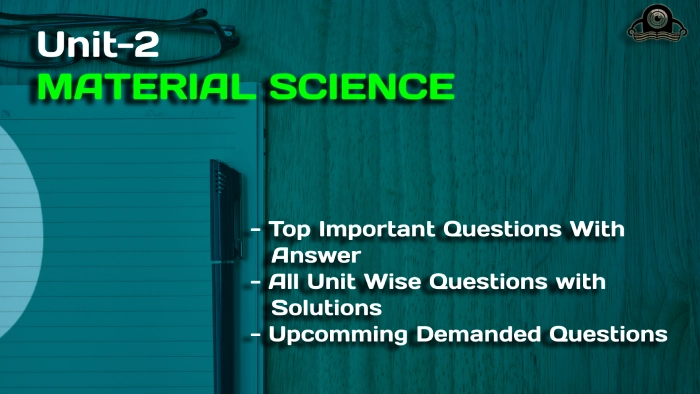We are discussing the Most Important Question in Unit-2 – AKTU Btech | MATERIAL SCIENCE Btech AKTU and other universities. We give important questions with solutions as well as study tools to assist students in the examination.
Hi there 🙏, make sure to keep this in mind also if you're seeking for additional useful information on this topic Important Questions For Material Science : *Unit-01 *Unit-02 *Unit-03 *Unit-04 *Unit-05 *Short-Q/Ans *Question-Paper with solution 21-22
Q1. Explain transformation of hypoeutectoid steel with slow cooling.
Ans. 1. If a 0.4% C hypoeutectoid steel sample is heated to around 900 °C (point an in Fig.) for a long enough time, its structure will become homogeneous austenite.
2. Then, if this steel is gently cooled to bin Fig. (about 775 °C), proeutectoid ferrite will nucleate and develop mostly at the austenitic grain boundaries.
3. In Fig., this alloy is gradually cooled from temperature b to temperature c. The amount of proeutectoid ferrite generated will rise until approximately half of the austenite is converted.
4. The carbon content of the remaining austenite will be raised from 0.4 to 0.8% while the steel cools from b to c.
5. If very slow cooling conditions occur at 723 °c, the residual austenite will undergo isothermal transformation into pearlite via the eutectoid reaction.
Austenite ➔ Ferrite ➔ Cementite
6. To distinguish it from the proeutectoid ferrite that occurs initially above 723 °C, the α ferrite in the pear lite is called eutectoid ferrite.
Q2. Discuss effects of alloying elements on the properties of steel.
Ans. 1. Steel is the most regularly used iron alloy. Steel characteristics are altered by the addition of alloying elements.
2. The effects of various alloying elements on steel are given below :
| S. No. | Alloying Elements | Effect on the Properties of Steel |
| 1. | Nickel | 1. Increases toughness. 2. Improve response to heat treatment especially in large sections . 3. In large amount provides special electrical and magnetic properties. 4. Improves forming properties of stainless steel. |
| 2. | Chromium | 1. Provides stainless property in steel. 2. Increase hardenability. 3. Increase high temperature strength. |
| 3. | Manganese | 1. Counteracts brittleness from sulphur. 2. Increases strength and hardness markedly. 3. Lowers both ductility and malleability if it is present in high percentage with high carbon content in steel. |
| 4. | Vanadium | 1. Improves response to heat treatment. 2. Provides control of structure. 3. Improves fatigue resistance . |
| 5. | Tungsten | 1. Retention of hardness and toughness at high temperature. 2. Enhances the effects of other alloying elements. 3. Improves high temperature strength. |
| 6. | Silicon | 1. High electrical resistance and magnetic permeability. 2. Increases hardenability. 3. Improves toughness. |
| 7. | Copper | 1. In small amount improves atmospheric corrosion resistance. 2. Act as a strengthening agent. |
Q3. Define the term diffusion. Explain Fick’s law in case of steady state diffusion.
Ans. Diffusion :
1.The movement of atoms or solids is referred to as diffusion.
2. Diffusion is the movement of atoms and molecules to new locations within a material as a result of heat agitation, resulting in compositional uniformity.
Fick’s Second Law :
1. Fick’s second law extends the first to non-steady state flow.
2. Fick’s first law calculates the instantaneous mass flow rate (flux) past any plane in a solid but provides no information about the concentration’s temporal dependency.
3. Fick’s second law contains the time dependency, which can be determined using Fick’s first law and the law of conservation of mass.
4. According to Fick’s second law,
5. Fig. is a schematic illustration of the time dependence of diffusion.
6. The t 1 curve represents the concentration profile at a specific point in time.
7. At a later time t2 , the concentration profile has changed. This change is due to the diffusion of B atoms that has occurred in the time interval t2– t1.
8. The t3 curve represents the concentration profile at a still later time.
9. The diffusion mechanism attempts to evenly disperse B atoms throughout the solid solution.
10. In addition, as time passes, the concentration gradient becomes less negative. This means that as the diffusion process develops, the diffusion rate slows.
Q4. Explain isothermal transformation diagram for Fe-C alloys.
Ans. TTT-Diagram :
1. Temperature-Time-Transformation diagram represents a relation between starting and ending of the formation of different micro structures.
2. Its shape is same as the English alphabet ‘ C’ so it is known as C-curve.
3. The nose of this curve indicates the least time taken for a particular transformation.
4. The critical cooling curve is the line that passes through the nose (or the tangent at the nose of the C-curve) and its slope is the crucial cooling rate.
5. The transition of austenite to pearlite is depicted in Fig. The leftmost C-curve depicts the beginning of austenite’s transition into pearlite.
6. This curve has 0% pearlite and 100% austenite. The dotted curve represents 50% austenite transformation into pearlite, and the rightmost C-curve represents 100% pearlite transformation (complete curve).
7. These curves are only valid for transformations in which the alloy temperature remains constant during the reaction.
8. Thus these plots are also known as isothermal transformation diagrams or TTT diagrams.
9. Depending on the cooling rate, various microstructures such as pearlite (coarse or fine), bainite, austenite + martensite, and martensite can be formed.
10.Line pearlite is produced via annealing when the cooling rate is slow.
11. The cooling rate is high during normalisation, resulting in the bainite structure.
12. A complete feature of TTT diagram to show its different phase is shown in Fig.
Importance of TTT Diagram :
1. It depicts the structure acquired at various cooling rates.
2. It graphically depicts the cooling rate required to convert austenite to pearlite, bainite, or martensite.
3. It depicts the amount of time required for transformation to various phases.
Q5. Give the composition, properties and uses of any three types of cast iron.
Ans. A. Cast Iron:
1. Cast iron is very useful engineering material. It contains more carbon percentage (approximately 2 % < C < 4.5 %).
2. Cast iron is created when pig iron is melted with coke and limestone in a cupola furnace.
3. Coke serves as a fuel, and limestone serves as a flux.
4. Fluxes are used to remove impurities from pig iron (like oxides and fuel ash etc.).
B. Properties of Cast Iron :
1. It has good hardness due to presence of high carbon percentage.
2. Its compressive strength is very good.
3. It has good machinability.
4. It has very good rigidity.
Uses of Cast Iron :
1. The most important use is to make the bed of lathe machines.
2. It is used for making the body structures of tools .
3. To reduce the cost of an IC engine, cylinder head and blocks are made of cast iron.
4. Leaf springs or laminated springs are made of cast iron.
5. Underground pipelines to supply oils and natural gases are made of cast iron.
Q6. State the comparison of cast iron, and mild steel.
Ans.
| S. No. | Cast Iron | Wrought Iron | Mild Steel |
| 1. | It contains 2 to 5 % carbon. | Containing 0 to 0.25 % carbon. | Contains 0.08 to 0 .35 % carbon. |
| 2. | It has a crystalline, coarse granular structure. | Fibrous structure of bluish colour. | Bright fibrous structure. |
| 3. | Hard and brittle. | Tough and more elastic than cast iron. | Tough and more elastic than wrought iron. |
| 4. | Cannot be magnetised. | Can be temporarily magnetised. | Can be permanently magnetised. |
| 5. | Neither malleable nor ductile. | Very malleable and ductile. | Malleable and ductile. |
| 6. | Cannot absorb shocks. | Can stand sudden and excessive shocks. | Absorbs shocks. |



Short Question | Long Question | Important Question | Quantums
Material Science Important Links:
| Label | Link |
|---|---|
| Subject Syllabus | Syllabus |
| Short Questions | Short Question |
| Important Unit-1 | Unit-1 |
| Important Unit-2 | Unit-2 |
| Important Unit-3 | Unit-3 |
| Important Unit-4 | Unit-4 |
| Important Unit-5 | Unit-5 |
| Question paper – 2021-22 | 2021-22 |
AKTU Important Links | Btech Syllabus
| Link Name | Links |
|---|---|
| Btech AKTU Circulars | Links |
| Btech AKTU Syllabus | Links |
| Btech AKTU Student Dashboard | Student Dashboard |
| AKTU RESULT (One VIew) | Student Result |
Important Links-Btech (AKTU) | Material Science Syllabus
| Label | Links |
|---|---|
| Btech Information | Info Link |
| Btech CSE | CSE-LINK |
| Quantum-Page | Link |
| Material Science Syllabus | Syllabus-material Science |

5 thoughts on “UNIT 2 Material Science – Important Question for FERROUS ALLOYS”